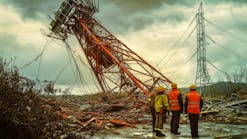By Ron Domitrovic, Customer Technologies Program Manager, Electric Power Research Institute
EPRI is doing extensive research into technologies which can provide grid resiliency that positive impacts customers in the commercial, industrial and residential sectors. Here, EPRI’s customer technology lead Ron Domitrovic highlights ways that businesses can ensure dependable heating and cooling systems during winter lows and summer highs.-- -- -- -- --
Last year saw extreme weather events across the U.S. that brought record-breaking temperatures in both winter and summer, causing major disruptions and capturing national media attention.
In the Great Plains and Texas, a polar vortex brought extremely cold weather including sustained single digit freezes for days in February. Then, in summer, the Pacific Northwest faced sweltering temperatures exceeding all-time highs of more than 100 degrees and driving communities to a standstill.
In both instances, the extreme temperatures pushed the limits of the existing heating and cooling equipment and energy systems. As once uncharacteristic weather patterns are expected to continue as a result of a changing climate, the Electric Power Research Institute (EPRI) continues to research customer technologies that advance efficient use of energy and enable affordable, environmentally responsible, reliable power service.
More cold weather is on the horizon and has already happened this winter, resurfacing conversations about new and improved heating systems that can ensure creature comforts in the most extreme conditions.
With these conversations in mind, EPRI recently released two white papers to help utilities and energy stakeholders better understand the operating dynamics of heating and cooling systems in these extreme weather events and how heat pump performance is affected by the extreme cold.
Operating Dynamics of Heating and Cooling Systems in Extreme Weather Events
Performance of vapor compression heating, ventilating, and air conditioning (HVAC) systems is temperature dependent. Units are sized to meet a building’s thermal load (the heat gain or loss) based on outdoor design conditions for a particular location. However, when outdoor temperatures are significantly beyond these design conditions, the cooling or heating delivered by the HVAC system may be insufficient to maintain comfort.
More extreme temperatures for longer periods of time can cause extended loading time and expose power system assets such as transformers to higher temperature operation, which may reduce lifespan.
So what can be done?
As electrification of heating and cooling continues in certain regions, utilities should capture both anticipated and unexpected extreme temperature system load dependencies into generation and distribution planning systems. EPRI’s Transmission Planning research program seeks to address these challenges and offers tools that utilities can use in system planning.
Another potential tool is adoption of variable-capacity HVAC systems. These systems offer options for extreme temperature operation, including flexible demand response , higher heating capacity, flexibility in sizing to accommodate wider ranges of cooling and heating loads, and relief from fault-induced delayed voltage recovery.
Cold Climate Heat Pumps
In the United States, conventional heat pumps offer energy-efficient space conditioning solutions for commercial and residential buildings. These air-source heat pumps can provide both heating and cooling of homes and are commonly used in the southern portion of the U.S. due to relatively mild winters. Use of heat pumps is expected to grow as they offer a low-carbon option for heating and cooling that can help achieve decarbonization goals. However, existing technology faces challenges deploying in cold climates as their capacity and efficiency decrease at lower outdoor temperatures. This makes large-scale adoption of heat pumps more difficult in climates below 35°F.
To better understand the performance challenges and potential solutions, EPRI conducted a study to investigate the performance of three heat pump variations: single-speed, multi-speed, and variable speed. Field testing demonstrated that variable-speed heat pumps can provide a higher proportion of their maximum heating capacity at low outdoor temperatures, including during the record-setting 2021 cold polar vortex. Additionally, because the variable-speed heat pumps are able to meet heating requirements at lower outdoor temperatures with the compressor alone, they reduce the electricity demand for supplemental heating.
Regardless of equipment type (single-speed, multi-speed, or variable speed), selecting the appropriate heat pump size is important for proper operation and efficiency, and requires carefully estimating both the design heating and cooling loads for the home.
At EPRI, our work will continue to explore the operational challenges, opportunities, and technology solutions that may be used to meet customer energy demands in extreme weather conditions. Researchers are optimistic about the potential for heat technology to advance and enable wider adoption and use in colder climate.
Just this December, the U.S. Department of Energy awarded the foundation a three-year grant to develop a new, energy efficient hybrid heat pump system for residential and commercial buildings. EPRI will work with the Oak Ridge National Laboratory to design a new heat pump which can operate in temperatures below 35°F. If implemented throughout the country, the hybrid heat pump system could reduce U.S. carbon emissions by 65 million metric tons by 2040, or the equivalent of eliminating all California’s carbon emissions caused by cars.
To learn more about EPRI’s research into Customer Technologies, including heat pumps, demand response systems, and other emerging technologies, visit EPRI.com.
-- -- -- -- --
Ron Domitrovic is responsible for leading EPRI’s Customer Technologies research. He leads a team of researchers aimed at understanding and applying efficient end use devices in such areas as thermal systems, lighting, data centers, water & energy and appliances. His technical focus is in the area air conditioning, refrigeration and thermal systems in buildings, which was his early career focus at the Oak Ridge National Lab.





